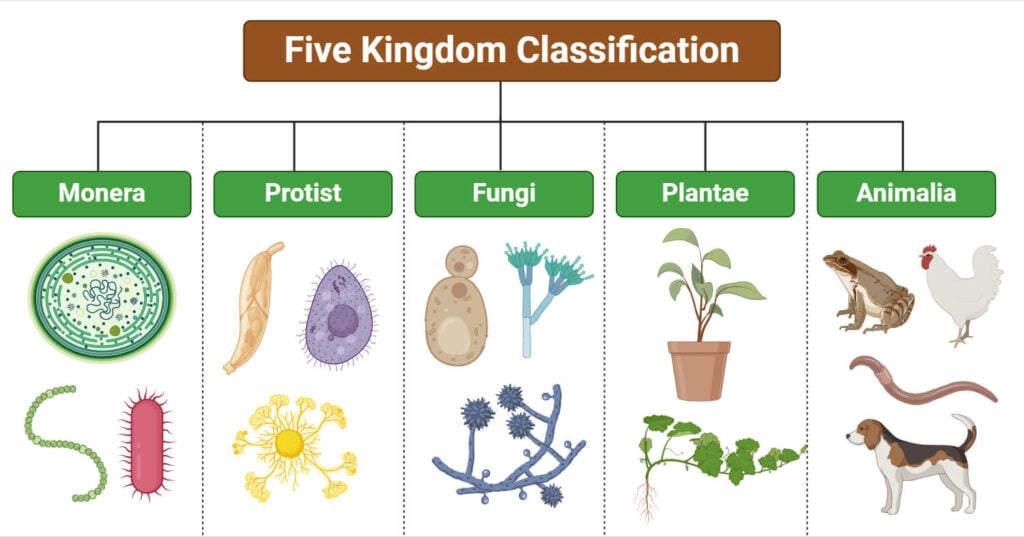- Taxonomy refers to the science of classification of living organisms.
- According to Bergey’s Manual of Systematic Bacteriology, taxonomy consists of three separate but interrelated areas: classification, nomenclature, and identification.
- Classification is the arrangement of organisms into taxonomic groups known as taxa on the basis of similarities or relationships.
- Taxa include kingdoms or domains, divisions or phyla, classes, orders, families, genera, and species.
- Closely related organisms (i.e., organisms having similar characteristics) are placed into the same taxon.
- Organisms are categorized into larger groups based on their similarities and differences.
- It should be noted that the classification of living organisms is a complex and controversial subject.

Interesting Science Videos
The Five Kingdom System of Classification
- Very early on, scientists began grouping the living organisms under different categories.
- Some biologists classified organisms into plants and animals.
- Ernst Haeckel, Robert Whittaker, and Carl Woese are some biologists who attempted a broader system of classification.
- Amongst these, the Five Kingdom Classification proposed by Robert Whittaker stood out and is widely used.
- In 1969, Robert H. Whittaker proposed a Five- Kingdom System of Classification, in which all organisms are placed into five kingdoms.
Features of Five Kingdom System of Classification
Whitaker proposed that organisms should be broadly divided into kingdoms, based on certain characters like the structure of the cell, mode of nutrition, the source of nutrition, interrelationship, body organization, and reproduction.
The kingdoms include:
- Bacteria and archaea are in the Kingdom Monera
- Algae and protozoa are in the Kingdom Protista (organisms in this kingdom are referred to as protists)
- Fungi are in the Kingdom Fungi
- Plants are in the Kingdom Plantae
- Animals are in the Kingdom Animalia
Kingdom Monera
- These organisms are prokaryotic and unicellular.
- They do not have a well-defined nucleus and also lack cell organelles.
- Some organisms show the presence of cell wall while there are others without a cell wall. Consequently, some organisms are autotrophic and others are heterotrophic.
- Examples include Bacteria, Cyanobacteria, and Mycoplasma.
Kingdom Protista
- Organisms grouped under Kingdom Protista are all unicellular, but eukaryotic organisms.
- These are the simplest forms of eukaryotes that exhibit either autotrophic or heterotrophic mode of nutrition.
- Some organisms have appendages such as cilia or flagella or pseudopodia to move around.
- Some examples are Diatoms, Protozoans like Amoeba, Paramecium
Kingdom Fungi
- Heterotrophic, Multicellular and Eukaryotic organisms are grouped under Kingdom Fungi.
- Their mode of nutrition is saprophytic as they use decaying organic matter as food.
- They have cell walls, which are made up of a substance called Chitin.
- Fungi also form a symbiotic association with some blue-green algae.
- Yeast, Mushroom, Aspergillus are examples of Fungi.
Kingdom Plantae
- These are Eukaryotic, Multicellular organisms with a cell wall that is made up of cellulose.
- They are autotrophs and synthesize their own food through the process of photosynthesis. This kingdom includes all plants.
- Based on the body differentiation and presence or absence of specialized vascular tissue, Kingdom Plantae is divided into different divisions, namely Thallophyta, Bryophyta, Pteridophyta, Gymnosperms, and Angiosperms.
- Examples are Spirogyra, Ferns, Pines, and Mango Plant etc.
Kingdom Animalia
- This Kingdom includes organisms that are Multicellular, Eukaryotic, without the presence of cell wall.
- They have a heterotrophic mode of nutrition.
- They also exhibit great diversity. Some organisms are simple while others have a complex body with specialized tissue differentiation and body organs.
- The Animal Kingdom is divided into many phyla and classes.
- Some of the phyla are Porifera, Coelenterata, Arthropoda, Echinodermata, Chordata etc. Examples – Hydra, Starfish, Earthworms, Monkeys, Birds etc.
- Viruses are not included in the Five-Kingdom System of Classification because they are not living cells; they are acellular.
- Four of the five kingdoms consist of eukaryotic organisms.
- Each kingdom consists of divisions or phyla, which, in turn, are divided into classes, orders, families, genera, and species.
- In some cases, species are subdivided into subspecies, their names consisting of a genus, a specific epithet, and a subspecific epithet (abbreviated “ssp.”)
An example would be H. influenzae ssp. aegyptius, the most common cause of “pinkeye.”
- Although Whittaker’s Five-Kingdom System of Classification has been a popular classification system for the past 30 or so years, not all scientists agree with it and other taxonomic classification schemes exist.
Limitations or Objections to the Five Kingdom System of Classification
- Some scientists do not agree that algae and protozoa should be placed into the same kingdom.
- In some classification schemes, protozoa are placed into a subkingdom of the Animal Kingdom.
- A distinction between unicellular and multicellular organisms is not possible in case of algae in this system of classification.
- Each group has so many diversities that it is difficult to keep them together. For example, monera and Protista contain both walled and wall-less organisms. Photosynthetic and non-photosynthetic organisms, cellular or filamentous organism.
- Virus has not been included in this kingdom.
- Archaebacteria differ from other bacteria in structure, composition and physiology.
- Mycoplasma are quite different form bacteria where they have been placed along with prokaryotes.
- Symbiotic associations are not considered in this classification system. For example, lichens are organisms which are formed by the symbiotic association between fungi and algae.
References
- Engelkirk, P. G., Duben-Engelkirk, J. L., & Burton, G. R. W. (2011). Burton’s microbiology for the health sciences. Philadelphia: Wolters Kluwer Health/Lippincott Williams & Wilkins.
- Trivedi P.C., Pandey S, and Bhadauria S. (2010). Textbook of Microbiology. Pointer Publishers; First edition
- Tortora, Gerard J., Funke, Berdell R.Case, Christine L.. (2013) Microbiology :an introduction Boston : Pearson,
- https://www.toppr.com/guides/biology/diversity-in-living-organisms/five-kingdom-classification/
- https://www.ruf.rice.edu/~bioslabs/studies/invertebrates/kingdoms.html
- https://www.tutorialspoint.com/biological_classification/five_kingdom_classification_disadvantages.asp
- http://drsamadsmicrobiologytutorial.blogspot.com/2011/07/merits-and-demerits-of-r-h-whittaker-5.html

This was just really interesting and now I know the different classifications of living and non living things